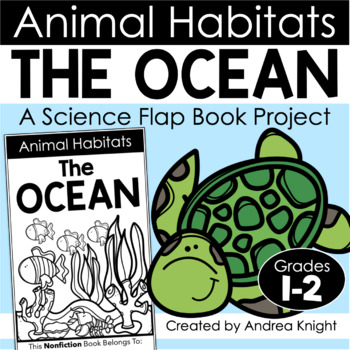Animal Habitats - Oceans - A Nonfiction Science Flap Book Project for Grades 1-2
- PDF
Also included in
- ANIMAL HABITATS BOOK BUNDLEThis bundled download includes each of the 7 ANIMAL HABITAT Flap Book Sets available in my TpT store.FEATURED HABITATS:The RainforestThe ArcticWetlandsThe OceanThe DesertThe Forest The Savanna THIS BUNDLED SET INCLUDES: One Flap Book per Habitat (2 for Savanna / Savannah)WPrice $20.00Original Price $28.00Save $8.00
Description
ANIMAL HABITATS - THE OCEAN
The Inspiration:
I wrote this student science text with the "You Read to Me, I'll Read to You" books in mind. (Mary Ann Hoberman) I love those two-reader books because they allow readers of different abilities to read together.
The Text Level:
If read individually, this science text is most appropriate for a second-semester 1st grader or a first-semester 2nd grader, but it depends on your students' needs. The text is already differentiated in its design, so it's perfect for mixed-ability partners to read together or for a child to read with a family member at home. The text on the bottom of each page is simple and predictable, but the "Fun Facts" are written at a higher level of text difficulty. See the PREVIEW for a sample of the text level.
The Format:
The book design is a FLAP BOOK where the FACTS are hidden underneath the pictures of the animals that live in this habitat. Key words have been underlined on each page to encourage new learning and deepen vocabulary. Large line-art images are perfect for coloring and clear directions are given for assembling the flaps.
The Animals:
The nonfiction text features the following saltwater marine animals. (See the preview.)
- whales
- sharks
- starfish
- clams
- fish
- crabs
A WRITTEN RESPONSE SHEET has been included for children to work on after closely reading the text. It can be done individually as an assessment or in collaborative small groups with discussion. (See the preview.)
TEACHERS LIKE YOU SAID:
⭐️⭐️⭐️⭐️⭐️ “We used this after reading a nonfiction book about the ocean. The students loved being able to have a book to take home!" (Melanie M.)
⭐️⭐️⭐️⭐️⭐️ “My class has enjoyed using this and the other habitat booklets to learn more about various habitats during science. I really like the comprehension questions at the end of each packet too." (Keli C.)
⭐️⭐️⭐️⭐️⭐️ “My students loved the flap books and enjoyed using them to do research." (Shelly F.)
The SEVEN BOOKS in this SERIES include:
- Animal Habitats: The Ocean
- Animal Habitats: The Desert
- Animal Habitats: The Forest
- Animal Habitats: The Savanna
- Animal Habitats: The Arctic
- Animal Habitats: Wetlands
- Animal Habitats: The Rainforest
Or SAVE more by buying the HABITAT BOOK BUNDLE.
Thank you for your interest in this item.
After purchasing, REMEMBER TO LEAVE FEEDBACK.
Each review leads to TPT CREDIT you can use for future purchases!
Copyright © Andrea Knight
All rights reserved by the author.
Permission to copy for single classroom use only.






